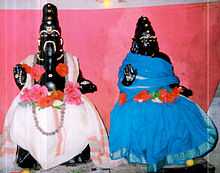Lopamudra

Lopamudra (Sanskrit: लोपामुद्रा) was a philosopher as per the ancient Indian literature. She was the wife of the sage Agastya[1] who is believed to have lived in the 6th or 7th century BC.[2] Together with her husband she is credited with spreading the fame of the Lalita sahasranama (the thousand names of the Divine Mother).[1] She is also called Kaushitaki and Varaprada. A hymn in the Rigveda is attributed to her.
In Mahabharata (Vana a: Tirtha-yatra Parva), there is a mention that Agastya Rishi did penance at Gangadwara (Haridwar), with the help of his wife, Lopamudra (the princess of Vidarbha).[3] According to legend, Lopamudra was created by sage Agastya with the most graceful parts of animals such as eyes of the deer etc.[4]
The name Lopamudra signifies the loss (lopa) that the animals suffered by giving their distinctive beauties (mudras). After creating her, Agastya secretly introduced Lopamudra into the palace of the King of Vidarbha. Agastya had made Lopamudra with the intention of marrying her. The king brought up Lopamudra as his daughter. When she grew up, Agastya demanded her hand in marriage. Lopamudra agreed to marry him and left the King's palace for his hermitage. However, after some time, she grew tired of Agastya's austerity. She wrote a two-stanza hymn, asking for his attention and love. The hymn made Agastya realize his duties towards his wife. The couple had a son named Dridhasyu, who became a poet.
It is said that the present day river Kaveri is Lopamudra's reincarnated form.
Giridhara Ramayana has a different story on Lopamudra. Agastya approached king of Kanyakubja who had many daughters for a girl in marriage. The king promised the sage a girl when they come to age and asked him to come back a few years later. By the time the sage returned, however the king had married off all his daughters. He was so worried about getting cursed, he dressed his son Lopamudra as a girl and presented him to Agastya. Miraculously, Lopamudra was transformed and became a woman after the wedding.
References
- ↑ 1.0 1.1 "Vedic Women: Loving, Learned, Lucky!". Retrieved 2006-12-24.
- ↑ "Siddha Central Research Institute". Retrieved Nov 19, 2013.
- ↑ Lopamudra The Mahabharata, translated by Kisari Mohan Ganguli (1883 -1896), Book 3: Vana Parva: Tirtha-yatra Parva: Section XCVII.
- ↑ "Encyclopedia for Epics of Ancient India: Lopamudra". Retrieved 2006-12-24.